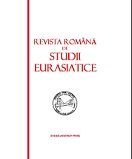CENTRAL EUROPE IN THE SECOND HALF OF THE 19th CENTURY. COMPARISON STUDY. CASE OF ROMANIA
CENTRAL EUROPE IN THE SECOND HALF OF THE 19th CENTURY. COMPARISON STUDY. CASE OF ROMANIA
Author(s): Iolanda ŢighiliuSubject(s): History
Published by: Ovidius University Press
Keywords: România; union; independence; kingdom; institutions; society; modernization; diplomacy
Summary/Abstract: In Europe, the 19th century was called “the century of the nations”. Between 1850 – 1900, the entire continent was involved in the spirit of modernization. This process determined the fundamental changing of the European society. Everything changed: ideas, institutions, way of life, mentalities. During the 18th-19th century, the relationships among central European states were very complex, conflicting, difficult and often antagonistic. From geopolitical point of view, the region is a turning point between Europe and Asia. The ethnical map of this space includes a great diversity: Romanians, Greeks, Russians, Serbians, Hungarians, Germans, Bulgarians, Albanians, Turkish, Jewish, Gipsies, etc. thus, the great potential of political conflict that led to many wars. The Ottoman Empire, The Russian Empire and The Hapsburg Empire (The Austro-Hungarian Empire since 1867) were the three “Great” that disputed the supremacy here, generating many wars. Being situated between these three empires, the Romanian Principalities were buffer states. They were vassals to the Ottoman Empire (from the second half of the 16th century). Thanks to diplomacy of balance, they managed to preserve their autonomy. In the middle of the 19th century, the Romanian Principalities (Wallachia and Moldavia) had to reach two historical goals: 1. Union and forming of the national state; 2. getting free from the Ottoman Empire domination. In 1877, Romania got free and its independence is recognized by the Great Powers. In 1881, Romania became kingdom. Prince Carol of Hohenzollern-Sigmaringen is crowned as a king (at 10th of may). He became king Carol the Ist. Romania undergoes a deep process of structural transformation: political, economical, institutional, fiscal, cultural and demographical.The Romanian society could now synchronize its develpment with Occidental Europe. In 1900, Romania was a modern european state. The occidental models had been adapted and assimilated. In order to defend its own economical and political interests Romania proved courage and firmness and also flexibility and diplomacy.
Journal: Revista Română de Studii Eurasiatice
- Issue Year: 6/2010
- Issue No: 1+2
- Page Range: 51-60
- Page Count: 10
- Language: English

